10 new cities under construction around the world
10 April 2024
With the world predicted to add 2.5 billion more urban residents by 2050, dozens of new cities are being built around the world. Lucy Barnard takes a look at some of the most eye-catching.
For many it started with Paul Romer’s photograph of seven young African men sitting on concrete bollards outside the airport in their capital city in order to read their textbooks.
The students, Romer said, were forced to sit under the airport streetlights to study at night because they had no electricity at home – a result of rules in their country which meant the national power company had to sell electricity at low subsidized prices making it uneconomic and lacking any incentive to hook up many customers.
In a TED talk in 2009, which has been viewed nearly 160,000 times, Romer, a Nobel prize-winning economist, argued that millions of people around the world are being trapped in poverty because of a system of bad rules, just like the ones preventing the African students from being able to use electric lights in their homes.
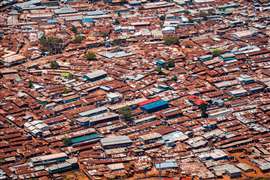 Aerial view of the Kibera neighbourhood in Nairobi, Kenya. Photo: Adobe Stock
Aerial view of the Kibera neighbourhood in Nairobi, Kenya. Photo: Adobe Stock
“Cities give you the opportunity to create new places with rules that people can opt into and they’re large enough to get all the benefits that we can have when millions of us work together under good rules,” Romer said.
Instead Romer’s key idea is to create new ‘charter cities’ – cities built from scratch and granted a special jurisdiction to create their own governance systems – emulating the success of Singapore, Shenzhen, Hong Kong and Dubai.
Of course, the idea of building new cities from scratch is nothing new and has been attempted with varying degrees of success by everyone from the Romans to Victorian industrialists, and exactly what counts as a city is open to debate, but with the world predicted to add 2.5 billion more urban residents by 2050, the speed and scale of development appears to be increasing.
Certainly, over the decade or so since, dozens of governments, corporations and wealthy investors, from Egypt to Arizona, have come up with their own proposals to create new cities and communities, throwing up huge opportunities for architects, planners, construction companies and others.
Here Construction Briefing takes a look at ten of the biggest and most eye catching new cities under construction around the world.
Nusantara, Indonesia (2,561 sq km)
With Indonesia’s ancient and overcrowded capital, Jakarta sinking at between 1cm and 18cm a year, plans to move the country’s seat of government have long been discussed. In 2017, the official search for a new location began. The preferred location is Nusantara, a rainforest location on the island of Borneo. Groundbreaking took place in August 2022 and work on a new presidential palace and government buildings is expected to be completed in time for an official opening on Indonesia’s independence day, August 17, this year. Work began on a new airport in 2023. The Ministry of Public Works and Public Housing is carrying out the construction of the air facility. The Ministry of Transportation is carrying out the construction of the land facility.
Gelephu Mindfulness City, Bhutan (1,000 sq km)
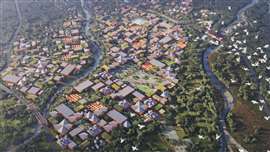 A rendering of Gelephu Mindfulness City, Bhutan. Image: Bjarke Ingels Group via Reuters
A rendering of Gelephu Mindfulness City, Bhutan. Image: Bjarke Ingels Group via Reuters
Announced by Bhutan’s king Jigme Khesar Namgyel Wangchuk in December 2023, Gelephu Mindfulness City, located near the town of Gelephu along Bhutan’s southern border with India, is expected to cover 1,000 square kilometers, equating to 2.5% of the tiny Himalayan country. Designed by Bjarke Ingels Group, the proposed metropolis is built around a series of inhabitable bridges which will house amenities including a new international airport, a university, a hydroponic greenhouse, a spiritual centre, a market for local goods and a hydroelectric dam. Construction of a new international airport and dry port have already started but there is no set completion date for the project.
Dholera Smart City, India (920 sq km)
Announced by Indian prime minister Narendra Modi in 2013 when he was chief minister of Gujaret, Dholera, Dholera Smart City is the first of eight planned ‘smart cities’ designed to be built across India in an attempt to reduce crowding and pollution, improve amenities and provide a hi-tech environment to encourage innovation. Located some 100km southwest of Ahmedabad and spanning 920 sq km, Dholera is India’s largest greenfield urban development. The project is being jointly developed by the Gujarat state government and the Indian national government. In 2017 Larsen & Toubro was awarded the contract to develop roads and services in the city centre. India’s first semi-conductor chip plant is expected to open in Dholera next year and a 4400MW capacity ultra-mega solar plant has been commissioned by Tata Power.
New Administrative Capital, Egypt (714 sq km)
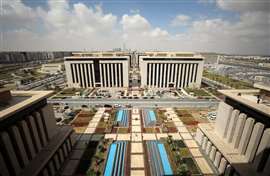 Generat view of government buildings in Egypt’s New Administrative Capital, east of Cairo in March 2024. Photo: Reuters/ Mohamed Abd El Ghany
Generat view of government buildings in Egypt’s New Administrative Capital, east of Cairo in March 2024. Photo: Reuters/ Mohamed Abd El Ghany
Egypt’s as-yet unnamed new administrative capital is a new urban community currently under construction 45 kilometers east of the country’s ancient capital Cairo. The 700 square kilometer project was first announced in March 2015 when the Egyptian government signed a memorandum of understanding with former Emaar chairman Mohamed Alabbar’s private real estate fund Capital City Partners. However, later that year, Egypt cancelled the MOU with Alabbar and signed a new MOU with China State Construction Engineering Company (CSCEC) to build the 1.71 million square meter central business district part of the project, comprising 20 towers and which includes Iconic Tower, Africa’s tallest skyscraper. Many Egyptian civil servants have already moved into the new office buildings. The new city will be linked to the capital via a new monorail which is currently under construction as well as by the Cairo Light Rail Transit.
California Forever, USA (202 sq km)
California Forever is the US-based corporation set up by former Goldman Sachs trader, Jan Sramek with the backing of numerous Silicon Valley investors including Steve Job’s widow Laurene Powell Jobs and LinkedIn co-founder Reid Hoffman. Since 2017 the company has spent an estimated US$900 million buying up 50,000 acres of farmland in southeastern Solano Country, California. In January 2024, the company announced plans to build a new community walkable of 20,000 homes for around 50,000 residents.
Belmont, USA (101 sq km)
In 2017 Microsoft founder Bill Gates made headlines around the world when one of his investment firms, Belmont Partners was reported to have bought a 24,800 acre plot of land near Tonopah, Arizona for US$80m. A press release from Belmont said that the firm was planning to build “a forward-thinking community” of 80,000 homes “designed around high speed digital networks, data centres, new manufacturing techniques and distribution models, autonomous vehicles and autonomous logistics hubs.” However, very little appears to have happened to the site since then with some critics suggesting that the land does not have access to enough water to support a planned development of this size.
The Line, Neom, Saudi Arabia (34 sq km)
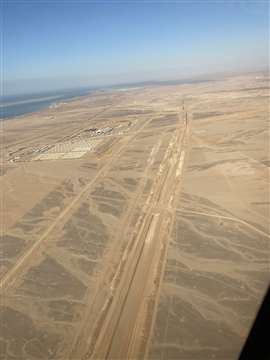 Excavations on The Line shown in February 2024. Photo with permission from NEOM
Excavations on The Line shown in February 2024. Photo with permission from NEOM
Built on a footprint of 34 square kilometers, The Line is a linear smart city currently being built in Saudi Arabia’s wider 26,500 square kilometer NEOM megaproject. The city, which has been designed to eventually accommodate a population of 9 million, roughly a quarter of Saudi Arabia’s current population, is shaped as a 170 kilometer long line running through the desert between the Red Sea and the city of Tabuk. The project comprises two long mirrored buildings separated by an outdoor space, will be just 200 meters wide but will soar to a height of 500 meters, slightly taller than Kuala Lumpur’s Petronas Towers. Announced by Saudi Crown Prince Mohammed Bin Salman in 2021, the city is planned to be powered entirely by renewable energy and will consist of three layers; one for transportation; one for pedestrians; and a third for infrastructure. According to officials, the development will consist 135 modules or connected communities, each measuring 800 meters long and linked via hyper-speed trains with no journey lasting more than 20 minutes. NEOM officials say the project will include no cars, streets or carbon emissions. Earthworks on the project began in October 2021 and a first phase is scheduled to be completed in 2030.
Al Jawahiri Residential City, Iraq (28 sq km)
The first of five new cities unveiled in 2023 in Baghdad as part of the government’s strategy to tackle the housing crisis and alleviate congestion in urban centres, Al Jawahiri Residential City, which is currently under construction to the west of the Iraqi capital Baghdad will comprise 7,121 acres, containing 30,000 homes and10,000 serviced residential plots. According to local press reports, contractors the East China Engineering Science and Technology Company and China National Chemical Engineering Company along with Iraqi company Shams al Binaa (part of SAC Group) broke ground on the project in December 2023. Construction is expected to take between four and five years.
Tatu, Kenya (20 sq km)
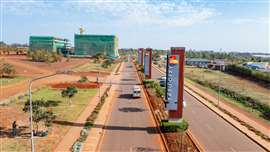 A view of the main approach to Tatu City. Photo: Tatu City
A view of the main approach to Tatu City. Photo: Tatu City
Tatu City is a 5,000 acre Special Economic Zone and charter city located 20km north of the Kenyan capital Nairobi which was once part of the Belgian Socfinaf coffee farm. The project, first announced in 2008, is owned and run by Rendeavour, a private property developer, founded by New Zealander Stephen Jennings, a former founder of Russian investment bank Renaissance Capital. According to the developer in March 2024, more than 3,000 homes and apartments are occupied or under construction in the city and 4,500 students study at Tatu City’s schools. The city is also home to around 75 local businesses. Rendeavour claims to be Africa’s largest urban land developer and is also building satellite cities in Ghana, Nigeria, Zambia and the Democratic Republic of Congo.
Próspera, Honduras (235,000 sq m)
Próspera is a semi-autonomous city, currently under construction on the island of Roatán, located around 65km off the northern coast of Honduras. The project is managed by US-based company Honduras Próspera Inc which is backed by a number of US tech entrepreneurs including PayPal co-founder Peter Thiel and was established under freezone or ZEDE laws by the Honduran government in 2021, designed to be unrepealable for 50 years. The community has adopted Bitcoin as legal tender and requires residents to pay an annual fee to live in the community. According to the company website, over 23,000 square meters of a planned 4 million square meter development at St John’s Bay has already been completed while plans have been drawn up for a 396 acre industrial park at the Port of Satuye and plans for another settlement at Port Royal on the island are at “pre-city vision stage.” However, in 2022 a new government in Honduras, headed by Xiomara Castro has signed legislation to repeal the country’s ZEDE legislation, leaving Próspera in legal limbo. The city is currently at the centre of a US$11bn legal battle between investors and the Honduran government at the World Bank’s International Centre for Settlement of Investment Disputes.
|
STAY CONNECTED



Receive the information you need when you need it through our world-leading magazines, newsletters and daily briefings.
CONNECT WITH THE TEAM








